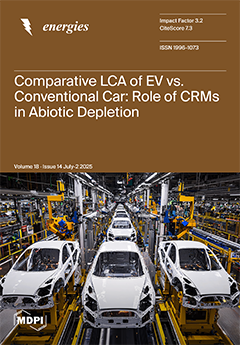Various pretreatment methods for the valorization of sunflower husks (SHs) for H
2 gas generation through fermentation by
Escherichia coli were investigated. We analyzed thermal treatment (TT), acid hydrolysis (AH), and alkaline hydrolysis (AlkH) at different substrate concentrations (50 g L
−1,
[...] Read more.
Various pretreatment methods for the valorization of sunflower husks (SHs) for H
2 gas generation through fermentation by
Escherichia coli were investigated. We analyzed thermal treatment (TT), acid hydrolysis (AH), and alkaline hydrolysis (AlkH) at different substrate concentrations (50 g L
−1, 75 g L
−1, 100 g L
−1, and 150 g L
−1) and dilution levels (undiluted, 2× diluted, and 5× diluted). A concentration of 75 g L
−1 SH that was acid-hydrolyzed and dissolved twice in the medium yielded optimal microbial growth, reaching 0.3 ± 0.1 g cell dry weight (CDW) L
−1 biomass. The highest substrate level enabling effective fermentation was 100 g L
−1, producing 0.37 ± 0.13 (g CDW) × L
−1 biomass after complete fermentation, while 150 g L
−1 exhibited pronounced inhibitory effects. It is worth mentioning that the sole alkaline treatment was not optimal for growth and H
2 production. Co-fermentation with glycerol significantly enhanced both biomass formation (up to 0.42 ± 0.15 (g CDW) × L
−1)) and H
2 production. The highest H
2 yield was observed during batch growth at 50 g L
−1 SH hydrolysate with 5× dilution, reaching up to 5.7 mmol H
2 (g sugar)
−1 with glycerol supplementation. This study introduces a dual-waste valorization strategy that combines agricultural and biodiesel industry residues to enhance clean energy generation. The novelty lies in optimizing pretreatment and co-substrate fermentation conditions to maximize both biohydrogen yield and microbial biomass using
E. coli, a widely studied and scalable host.
Full article





